Woodborough’s Heritage
An ancient Sherwood Forest village, recorded in Domesday
Nineteenth Century Woodborough
A Report by the Woodborough Local History Group - for the Session 1973-74
This report is issued at the end of the second year of research by the Local History Group of Woodborough. The report on the work done during the year 1972-1973 has already been circulated. A review of it is to be found in the Bulletin of Local History 1974, page 62-63, and copies have been deposited in the County Record Office and the Nottingham University Library.
Unfortunately, this year, because of the financial restrictions, it will not be possible to reproduce all the draft papers produced in the 1973-74 session. A full list of all of them is given below and they will be available for reference by the Group. It is expected that when the work of the Group has proceeded further, the papers will be published.
However, two of the papers of the 1973-74 session have been duplicated. They have been chosen as being particularly relevant to the work of the Group during the coming session 1974-1975.
Papers produced during session 1973-74
General Topics
- A Short History of Woodborough - Miss P J Turner
- Woodborough Feast during the Nineteenth Century - Mr J M Foster
- Notes on the Methodists - Mr J M Foster
- A Memory of Woodborough 70 Years Ago - Mrs F Wright
- The Woodborough Brass Band - Mrs E Wint & Mr J M Foster
Enclosure Topics
- The Enclosure Award 1798 - Mr G Welby
- Alterations in the Size & Tenancy of Farms during the Nineteenth Century - Miss P J Turner
Social Topics
- The Children of Woodborough 1851 - Mrs G Lichfield & Mrs J Littlewood
- The Women of Woodborough in 1851 - Mrs J Hobbs
- Where They Lived 1798 – 1871 - Miss P J Turner
- The Ward Family in Woodborough - Mrs J Hobbs
Maps Produced
- The Map of the Enclosure of Woodborough 1798 - Mrs E Wint
- The Pre-Enclosure Award Map (constructed from research done on the Enclosure Award) - Mrs E Wint
Working Papers Produced for use in Further Studies
- A Set of Reference Chits relating to Every Child in Woodborough in 1851 - Mrs G & Mrs J Litchfield
Draft Papers Duplicated at this stage
- Studies based on the Enclosure Award
- Studies on the Women & Children of Woodborough in 1851
Proposals for Future Work
- During the Session 1974-75 it is proposed that the Group should complete the study of the Women and Children of Woodborough in 1851 and open up the study of the Census Return of 1871.
Life in Woodborough in the Mid-Nineteenth Century
A first report by the Local History Study Group for the Session 1972-1973.
Members of the Local History Group
Mr Colin Bayley
Mrs Joyce Guy
Mrs Anne Halliday
Mrs Daphne May
Mr Bertram Meaden
Mrs Cathryn Perry
Mrs Freda Burton
Mr S. Savage (deceased)
Miss F. Swann
Mr Glynne Welby (tutor)
Mrs M. Wint
__________________________________________________________________________________________
Contents
Introduction – by the tutor
In October 1972 ten adult students, interested in local history, met at the Woodborough Woods Foundation School to investigate the social history of the village in the nineteenth century. The source material selected consisted of the enumerator’s schedules for the Census of 1841 and 1851. In addition the Parish Registers from 1813 and various maps and directories were available.
After discussion the Group set itself, as its first aim, an investigation of the occupations of the people of the village aged 14 and over for the period 1841-1851. Subsequently, members of the Group broke up into smaller sub-groups and began a further investigation of various aspects of the community of Woodborough in the mid-nineteenth century.
This report sets forth the work achieved after one winter’s meetings. It is clear that much has been achieved and that much remains to be done. Ideas for future work by the Group are set forth in Part III of this report.
Of the original ten members of the Group eight remained with us at the end of the Session. It is with deep regret that we have to record the death of one member Mr S. Savage. His memories of bygone days were a most important source of information and he is sadly missed. Mr B. Meaden retired when he had to undergo an operation; our best wishes are extended to him.
The Group would be most happy to welcome new members. The main object of the Group is to research, but the work does not require any specialised knowledge, nor does it involve work outside the normal one evening per week, although some members become so interested that they do undertake more. This is entirely a matter of personal choice.
The Group would like to thank the Reverend G.L. Halliday for allowing them to use the Parish Church Registers, Mr Les Morgan, Parish Clerk, for allowing them to use the Parish Burial Registers and Mrs Anne Halliday for allowing them to use her sitting room for many of the meetings.
Future Plans: The present intention is that the Group will meet again next autumn on Monday evenings. The main lines to be pursued will be Enclosure of Woodborough, an investigation of the origin of the present farms, fields, hedges and roads, secondly a continuation of the work already started on nineteenth century housing and thirdly a closer look at the children of Victorian Woodborough.
__________________________________________________________________________________________
Part 1
A first survey of the occupations of Woodborough 1841-1851
In reviewing the Census enumerators’ classification of occupations at the 1841 and 1851 Census we come upon the usual problem of how to reduce a large number of “occupations” to a manageable size and how to group them systematically. Forty-five occupations were recognised by the Group for the years 1841 and 1851 some of which are, in fact, envelope classifications. For example, we decided to place all workers in wood under the general title “Woodworker” regardless as to whether a person was styled in the Census as carpenter, joiner, cabinet maker, etc. In the socio-economic groups we experienced the usual problem of how to classify dependents and retired. Under what heading, for example, does one classify “late shoe maker” or “formerly farmer’s wife” or merely “Hannah Geelton – at home”. We decided that a common sense ruling based on evidence as to age, relationship to other members of the family and our knowledge of general working conditions, as explained by oral evidence, must be used in these cases. In fact our Group called “retired dependent” consists of four women who in 1841 were aged over 70 (two were aged over 80) and of thirteen people in 1851, ten of whom were over 64 and three aged between 33 and 47 and definitely listed as “dependent”. People of independent means have their own group. As regards major divisions of occupation we found that the village fell into seven main groupings:
1. Domestic Textile Worker This was the largest division both in 1841 and in 1851. It consisted in 1841 of 40.1% of the parish over 14 years, 42.5% of the men and 42.1% of the women.
2. Agriculture The second largest division for both years. It consisted in 1841 of 37.1% of the parish over 14 years, 38.1% of the men and 35.1% of the women and in 1851 of 28.4% of the parish over 14 years, 33.4% of the men and 22.4% of the women.
3. Other Work (less professional people) The third largest division consisting of all those at work who did not fit into the categories listed below (numbers 4-7). This was, in 1841, 19.8% of the parish over 14 years, 17.4% of the men and 22.9% of the women and in 1851 21.1% of the parish, 19.9% of the men and 22.5% of the women.
4. Professional People
5. Dependents There were no paupers listed as such in 1841 and 7 listed in 1851. The others are dependents maintained by their relatives at home.
6. People of Independent Means There were 9 in 1841 and 12 in 1851.
7. Visitors There were none in 1841 and 8, all female, in 1851.
In categorizing the occupations by sex (only people over 14 years old were considered for this purpose) we came up against the problem of how to classify the female population. After discussion we decided to show the total of all females and a breakdown into the enumerators’ classification of “wife” and “daughter” but those unmarried females actually shown as engaged in an occupation are shown as such (column I in the Numerical Report) and not as “daughters”. Only in the case of Domestic Textile workers was it possible to extract the nature of the work of the “wives”. Details have been indicated in note (d) of the Numerical Report.
We felt that many of the women shown simply as “wife” or “daughter” were undoubtedly in a full or part-time occupation, but also that this would vary in intensity according to the occupation of the “head of household”. It seems likely that, for example, a farm labourer’s daughter or a frame-work knitter’s daughter, for whom no occupation is given, would be more likely to be employed on the soil or in tasks connected with weaving; than would the wife or daughter of a carrier (even so one can never be certain about such matters). Another reason for our adopting the sub-classification of females was to facilitate any future work carried out on social studies.
As was to be expected, the domestic textile workers and those engaged in agriculture dominate the scene. Accordingly members of the group produced a brief description of these main occupations as practised in Nottinghamshire in the mid-nineteenth century, while the more mathematically minded group members were dealing with the final checking of the statistical information. In addition three large-scale maps of the village, based on the 25 inch survey of 1889, have been produced. It is hoped to use these, in the future, for work on re-housing projects based on the 1841 and 1851 census returns and also for general reference connected with other studies.
Statistical report on the occupations of the people of Woodborough based on the enumerator’s books for the census of 1841 and 1851. The report is based on the inhabitants aged 14+ at the time of the census. (Compiled by all members of the Group).



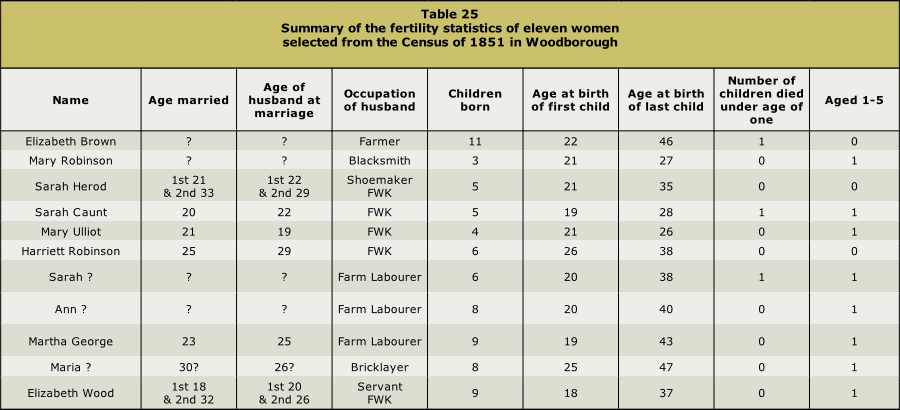
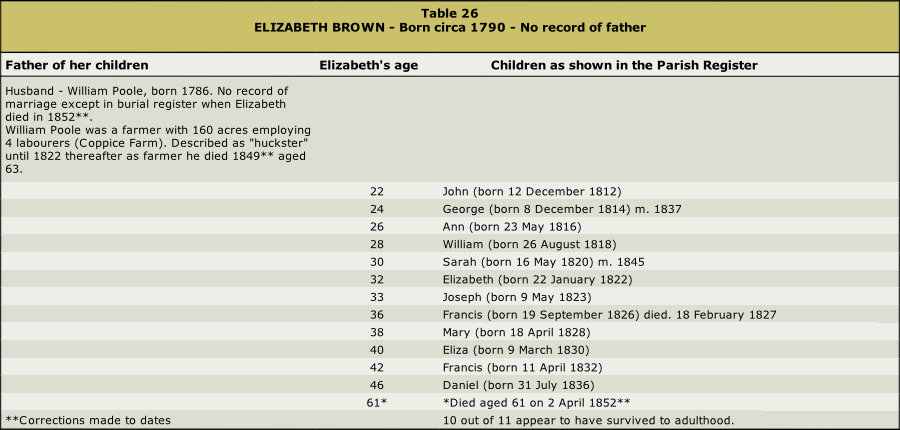






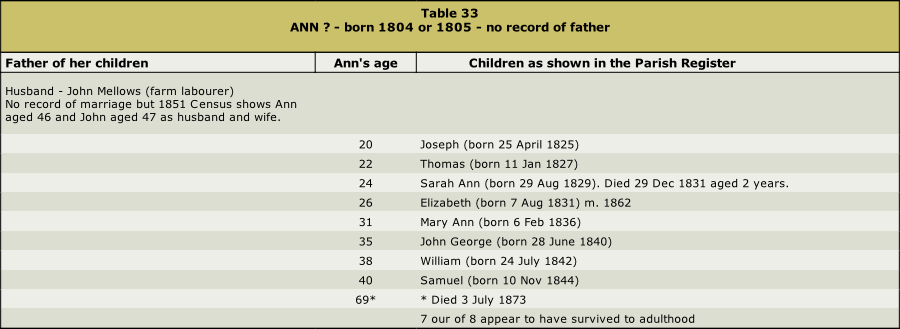
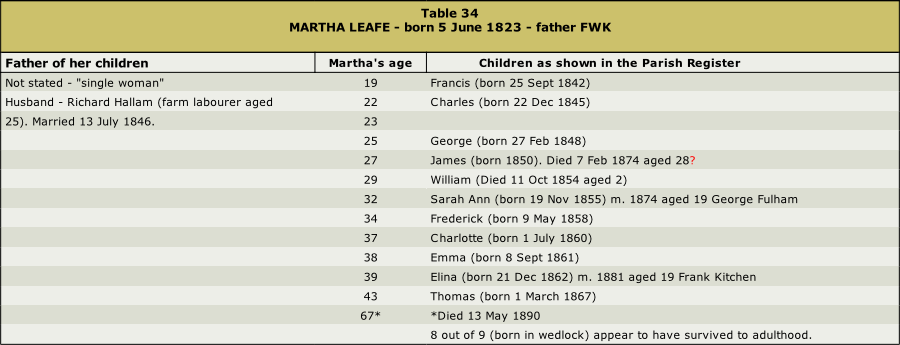
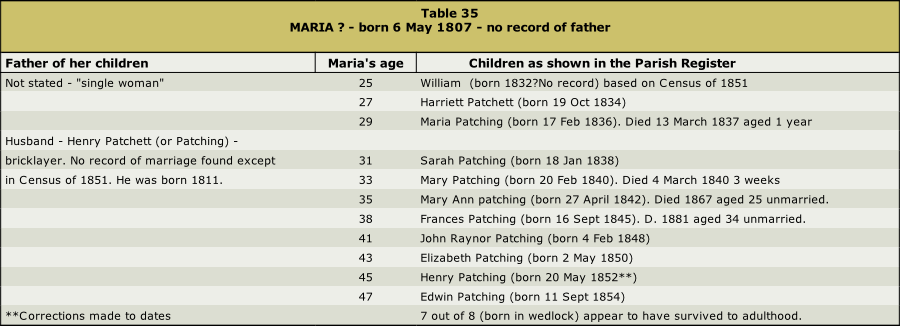
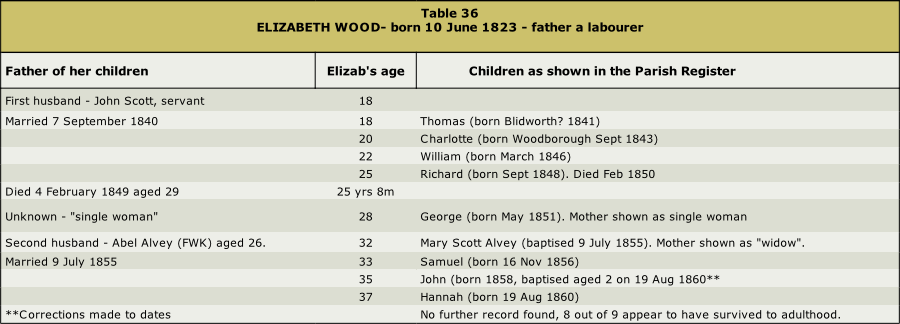
A first report on children under fourteen in
Woodborough in the census of 1851
By Miss F. Swann
According to the Census of 1851 there were 298 children under fourteen years of age. Of these 151 are described as “scholars” and 41 as in some employment, 3 are described as “visitors” and 3 as “lodgers” (one of whom was only 1 year old).
Those children who were employed were, for the most part, in the same (or an allied) trade as their parents. For example, among the Framework Knitters there are 29 seamers, 5 Framework Knitters, 3 Frame Smiths, and 7 House Servants (all girls), and one Errand Boy.
It is interesting to learn that none of the children of 1851 were employed on the land and the only farm workers’ children shown on the census as in employment, are all employed in domestic industry. Probably agricultural work, such as weeding, singling turnips, crow scaring and so forth, was too haphazard a rank as “employment” to those who drew upon the census.
As the age of the children employed, the FWK’s, are boys aged 12-13 years, the 2 Frame Smiths are 10 to 13 years, the seamers and glove stitchers, on the other hand, vary considerably, one is mentioned as 5 years and one as only 4 years.
Of 30 FWK families examined, there was an average of 3.5 children per family, and of 25 Farm Workers’ families examined again 3.5 children was the average number per family. For most families on the Census there is a period of about 2 years between the births of each child.
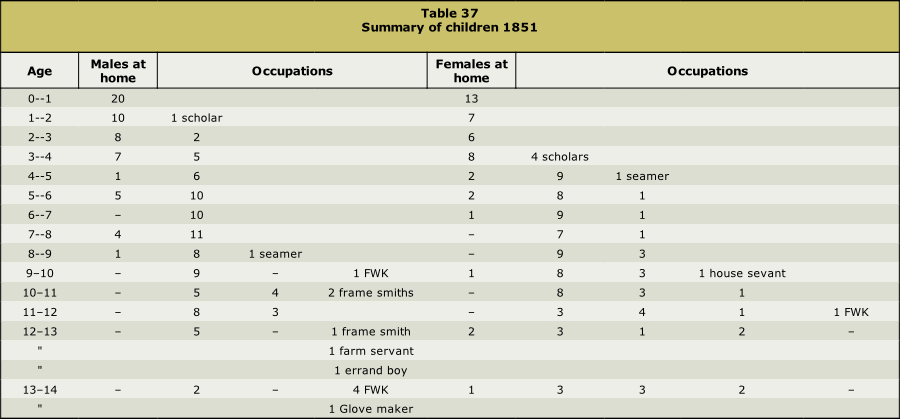
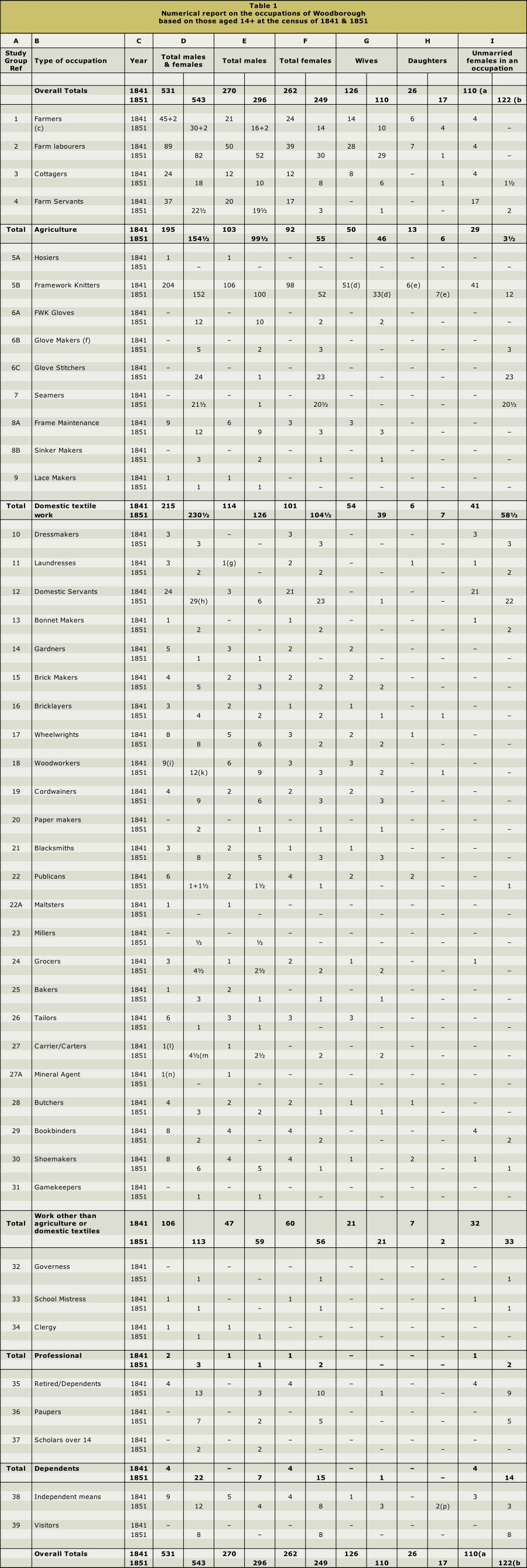
Notes on the above ‘Numerical Report’
(a) In addition to the “unmarried females in occupation” which includes daughters shown as in an occupation, there are also to be considered 29 Framework Knitters [FWK] wives shown in 1841 as working as FWK. No doubt many, or even most of the farm labourers wives and daughters worked as well, but this is not shown in the enumerator’s returns.
(b) In addition 28 FWK wives are shown in 1851 as working as FWK. See (a) above.
(c) People engaged in two occupations are shown under each occupation as a ½.
(d) Of the 51 FWK wives shown in 1841, 29 are shown as working at FWK. Of the 33 FWK wives shown in 1851, 28 are shown as working at FWK.
(e) These daughters are not shown as engaged in FWK.
(f) FWK shown in 1851 as making gloves.
(g) The male in “laundress” is the laundress’s son (1841).
(h) Includes one coachman and his wife (1851).
(i) Includes 1 carpenter, 4 joiners and 3 wives, and 1 apprentice joiner (1841).
(k) Includes 5 carpenters, 1 carpenter’s apprentice and 1 joiner (1851).
(l) The Directory shows two carriers – George Poole, who appears in the census for 1841, and John Bish, who does not. He held “freehold house and the land” according to the Electoral Register 1841 and 1851.
(m) The Directory shows three carriers – John Bish, who does not appear as such in the 1851 census, and George Poole and William Wright who do. In addition, the 1851 census shows Joseph Leafe, who does not appear in the Directory. George Poole was 70 years old in 1851 and appears to have worked part-time since he also had a smallholding of 12½ acres.
(n) The Mineral Agent was John Chosewarm aged 55, not born in the county (1841 census).
(p) One daughter is the sister of a man of independent means (1851).
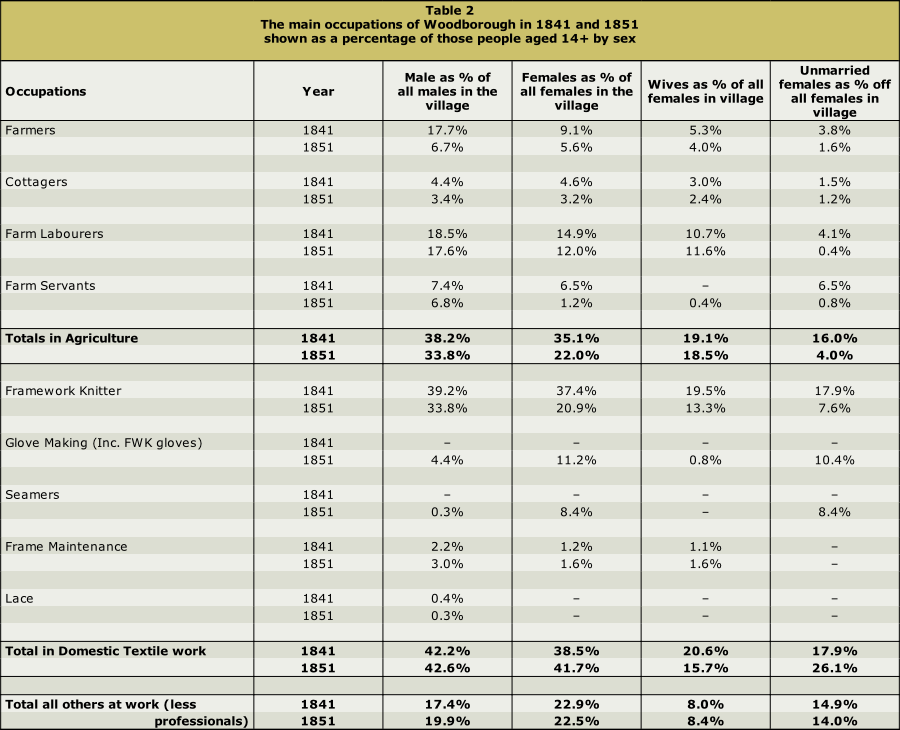
A Summary of the Statistical Report on the Occupations of Woodborough in 1841 and 1851



Notes on reports 3 to 5 above:
(a) These are the figures actually given in the census as the numbers of wives working in Domestic Textile occupations.
(b) It is assumed that most wives of those engaged in agriculture would at some time undertake some work connected with farming.
(c) There is no indication as to whether or not these wives worked, apart from their household duties.
(d) These figures represent the unmarried females of the main working population whose occupation cannot be ascertained. It is presumed that most of them had domestic duties and many may have had some other occupation.
The changing pattern of employment in Woodborough 1801-1851
By Mr Colin Bayley
Introduction: The purpose of this paper is to review the changing pattern of employment in Woodborough over the period 1801-1851. The sources used for this work are the published Enumeration Abstracts for the 1801, 1811, 1821 and 1831 Censuses, and the analyses made by the WEA Woodborough Local History Group of the Enumerators’ returns for the 1841 and 1851 Censuses. (Life in Woodborough 1841-1851. First Interim Report Section III).
Research Problem: The principle problem encountered in undertaking this project was the lack of comparability of data. The 1801 Census Enumeration Abstract shows a breakdown of the number of persons into the categories: Chiefly Agriculture: Trade – Manufacturing and Handicraft; and other.
The 1811, 1821 and 1831 Abstracts show a breakdown of the number of families into the same categories; and, additionally, the 1831 Abstract gives an analysis of the occupations of the male inhabitants over 20 years of age into nine occupational categories. A full analysis of the occupations of the inhabitants over 14 years of age is available for 1851 (Life in Woodborough 1841-1851. First Interim Report Section III), and also an unverified analysis of the main occupational groups of the male inhabitants over 14 years of age for 1841. (Prepared by WEA Local History Group). This data is tabulated below, Tables 6-9.
In preparing this paper, the data for 1801 has been discounted because it is considered that is it probably unreliable. The data for 1811-1851 has been brought together in Table 10, and, as far as is possible, general conclusions brought.
Discussion and Conclusions: Table 10 shows the percentage analysis of employment by category, 1811-1851. In studying table it must be remembered that:
1. Whilst there must be, in general terms, a relationship between the employment categories of families and those of adult males, the problem of families with more than one adult male means that there is not necessarily a close correlation. The discrepancies between the two data sets for 1831 highlight this problem.
2. There may not be a close correlation between the occupational distributions of male inhabitants aged 20+ years (1831) and those aged 14+ years (1841 and 1851).
Notwithstanding these difficulties, it may be concluded that the pattern of employment in Woodborough during the first half of the 19th century was one of a movement away from agriculture towards domestic textile work, and other crafts and trades - 47.8% of families in 1811 were engaged in agriculture, 42.2% of families in 1831, and 33.4% of males aged 14+ years in 1851.
The data in Table 10 also suggests that the number of adult males engaged in domestic textile work levelled-off at 40%-45% of the adult male population in the period 1831-1851, and indicates that, as early as 1811, less than half of the families of the village were engaged in agriculture.
It is hoped that further research will determine:
- The pattern of the growth of the domestic textile industry in the village up to 1841-1851, and also its development in the second half of the 19th century.
- Whether the agricultural sector declined rapidly after Enclosure in 1795, or whether, by the time of Enclosure, agriculture had ceased to be the occupation of the large majority of the population.




A Brief Description of Framework Knitting
in Nottinghamshire during the mid-19th Century
by Mrs D. May
By the middle of the 19th century the conditions of framework knitters were very poor. They worked from daylight until 10.0 o’clock at night for a very poor livelihood. Children from the age of eight to nine were employed usually in winding, but also seaming. This appears to have been done with the parents’ blessing, probably because even the small wage the children brought in was better than no wage at all. In 1843 a petition complaining about conditions in the industry and signed by more than 25,000 framework knitters was presented to the House of Commons. Two years later, in 1845, when an enquiry was ordered into the conditions of framework knitters of the Midlands, a decline in the silk hosiery trade was reported to have set in. During the first half of the 19th century there was a gradual disappearance from the market of the many different kinds of hosiery which had been worn at the beginning of the century, thus putting many frames out of work. At this time a tenth part of the output was sold in England, the rest going abroad.
Gradually during the 19th century framework knitters workshops disappeared owing to the work being more and more absorbed into factories. However, Woodborough was one of the villages where a superior class of silk hose and hosiery seaming were still carried on until much later. The scale of prices paid to stocking makers for work gradually declined from 1811 onwards. In 1833, earnings averaged 6/- [six shillings] per week on a narrow frame and from 9/- [nine shillings] to 12/- [twelve shillings] on a wide frame. A framework knitters’ expenses per week were on average as follows:-
Rent 1/3d [1 shilling and three pence] to 2/6d [2 shillings and sixpence], depending on the size of frame, needles 2d [two pence], ½lb of candles, for eight months of the year, 3½d, oil 1d, seaming 1/5d.
The system of hiring out frames was tyrannical and cruel, many deductions being made. The workers were compelled to hire their frames from the master stockinger, who refused to employ any workmen who did not comply with the regulations laid down.
Great damage was done to the industry during the first half of the nineteenth century by the system of colting. Colts were men who became stocking makers without having served an apprenticeship. If someone had saved £150-£200 they could pay a premium of between £5 and £10 to learn the art, and then after only six months they would set up with ten or twelve frames, which the poorer but skilled workmen could not afford to buy.
Although at the time in question framework knitters were very poorly paid, they do not seem to have been any less fortunate than any other workers of the time. This was a time of general depression, and in fact although the population at this time was rising, the number of persons in trade and manufacture actually decreased.
From 1861 onwards the application of steam power to the hosiery and lace making industries began and gradually the men and women who had worked in their own homes moved into large factories. The framework knitters do not appear to have welcomed this move, probably because it meant moving from their homes, where in spite of being underpaid and often the victims of corrupt practices, they were, to a large extent, their own masters.
A Brief Description of Agriculture in Nottinghamshire
in the mid-nineteenth century
by Miss F. Swann
After the period of the Napoleonic Wars when prices rose, land sold for above its real value - a period of artificial prosperity - came the inevitable depression. In Nottinghamshire rents fell by 30%, and the labourers were reported by various parishes to be in great distress for want of employment. Their wages were on average 12/9d per week, but in some places men were working for as little as 1/- per day.
This distress lasted about 20 years. 1838, with the foundation of the Royal Agricultural Society, marks the return of the tide, and the next thirty to forty years were the most prosperous time ever enjoyed by English farmers. It was said in 1844 that no part of England had undergone such a change for the better as had Nottinghamshire; where formerly had been vast tracts of waste land on which only the rabbit browsed, nutritious pasture in the summer and fine crops of corn of the best quality was the order of the day.
The great landowners did for Nottinghamshire what Cohe of Hollsham had done for Norfolk in an earlier day. The Duke of Portland was the first to use bone for manure, he was an energetic drainer of land; the 300 acres over 7 miles in length in the Mansfield District raised the annual value of the land enormously. The Duke of Newcastle let allotments near towns and villages which greatly improved the condition of the labouring man. But perhaps the main cause of the improved state of farming in the district was the introduction of the swede turnip by Colonel Mellish of Blythe, who distributed portions of seed to leading farmers. Slicing machines were invented, drills were used for planting, and the swede was described as “the sheet anchor of the farmer”. Machinery in fact was beginning to come into use on the land; as the century progressed large traction engines appeared on the farms, which posted on each side of a field drew a plough across and across by means of a cable.
Livestock also was much improved. In cattle, the Shorthorn took the place of the Longhorn, and sheep, which had been poor in the preceding century, became famous with the introduction in the middle of the nineteenth century of the pure Leicestershire breed and a cross between Lincolnshire and Yorkshire breeds. As much as one thousand guineas was paid for the hire of a ram for a season. Horses of the breeds of Clydesdale and Shire were now at work at the plough, the latter remarkable for strength – and speed. A farmer in Yorkshire is reported to have said when a labourer was complained of as being slow and lazy “Let ‘im go w’t Shire”. But no animal changed for the better as much as the pig. From being the long-eared coarse animal of the past, in now became compact, well-balanced like the Large Whites, Middle Whites, and Lamworths etc. of today. In the rich lands between Nottingham and Newark, worth from 35 to 65 shillings acre, it was the custom on many of the larger farms to provide the head man with a larger sized house, rent free: he undertaking to lodge and board the unmarried labourers, men and women. His wages were from £25 to £30 a year; he was allowed 1/- a day for the board of each man, with stated quantities of milk, fuel, pork and malt for himself and the others yearly, This is probably a late example of the way all businesses, whether agricultural or craft - bakers, fishmongers and the like - were conducted in mediaeval times; a group of people, under the control of the head of a family, consisting of his wife, children, apprentices, journeyman all living under one roof and subject to his control. Separate quarters were allocated to men and women: a farm where this can even now be discerned is still standing on the outskirts of Gedling: that it was the way of life of noble households is illustrated by the layout of Gainsborough Old Hall. Conditions were not so good and wages not so high on the sandy soil of the ancient Forest of Sherwood, but Woodborough, standing on the belt of clay, would share in the general prosperity. Farm labourers in the Forest in 1868 got from 13/- to 15/- a week, with garden and cottage usually rent free, but in districts like Woodborough a man could earn 3/- a day; cottage rents varied from £2.10s to £5 per annum. The aristocrats of the agricultural world, the horsemen, shepherd, head cowman, craftsman such as the thatcher, received a much higher wage and usually had rent-free cottages close to the farm. There were bonuses for all at harvest and hay-time, when the whole family worked in the fields, and at least one good “blow-out” for everyone once a year at the harvest-home dinner.
Nevertheless the standard of living of the agricultural labourer in the nineteenth century was low according to modern ideas. His cottage was small, usually one room up and one down; he certainly had a garden in which he grew potatoes, and plenty of green food, cabbage, lettuce, radishes and young onions. Practically everyone kept a pig in a lean-to sty at the end of the cottage, and this provided meat throughout the year, beef or mutton being a luxury only occasionally eaten on Sundays. If fowls were kept eggs could vary the diet: in summer they could be bought for 1/- for twenty. Butter was too expensive for general use, 10d. a pound, and the ordinary family used lard, home-produced, and often flavoured with rosemary. Bread and lard was the breakfast for most labouring families. The father might spread mustard on his: the children a little black treacle. Milk also seems to have been a luxury in some district of Oxfordshire in hamlets far from the farm-house dairy: it was certainly cheap, 1d a pint, and the “pint” covered any utensil produced, but it had to be fetched and the carrying of water from the village pump seems to have been a sufficient chore, for few cottages had their own water supply, although all had a water-butt to catch rain from the roof which could be used for washing. The main meal of the day was taken in the evenings when the men and boys were home from the fields: bacon from the flitch, vegetables from the garden and roly-poly pudding, flour with currants or jam rolled in a cloth, all cooked in one utensil over the fire. There was no money left over for luxuries, the rent had to come out of the weekly wage, and coal was a necessity, 1/- a cwt. [hundredweight] in the Midlands. Clothes and especially boots were a problem, those families with elder girls in service faired better here, for the daughters sent home their own cast-offs, and any articles given them by their Mistress: the extra earnings at harvest were often used to provide strong hobnailed boots for the family, necessary in fields and on muddy village tracks. Harvest-time also presented another bonus in the form of “leizings” – gleanings from the cornfields made by the women and children and then taken to the miller to be ground.
The closing decades of the nineteenth century saw the end of this prosperity. Free trade, in the form of cheap American corn which poured into the country meant the ruin of English agriculture. Disraeli, in his early ministry, prophesied that cheap corn from abroad would sound the doom of corn-growing in this country: when he came to power in 1774 he did nothing to reverse the trend, if that had been politically possible at that stage. The rate of decline was hastened by two successive bad seasons: the terrible rains in 1879 and 1880 meant that land in the midland, western and southern counties was utterly waterlogged. In the neighbouring county of Northamptonshire the River Nene overflowed its banks and washed away the crops of hay for two years running. The mildewing corn sprouted in the stooks. In this disaster the sandy lands of the old Forest district were more fortunate, but none of the heavy clay escaped. Of a flock grazing on the low land at Bulwell regularly flooded by the River Leen not one was saved. At Kelham, near Newark, all the sheep died or had to be killed owing to flukes [parasitic flatworm].
Even so, Nottinghamshire did not suffer as much as many counties, but everywhere bankruptcies were common, land went out of cultivation, which meant unemployment for the labourer, and there was an increased exodus to the towns to find a means of livelihood.
This decline in agriculture lasted well into the twentieth century “till by the year 1920, rural England was an agrarian remnant, an almost lifeless shell” (Peter Laslett).
Sources:
Victoria County History
Peter Laslett, “The World we have Lost”.
Extracts from 19th Century writings
Flora Thompson, “Lake Rise”.
Hearsay (!!)
________________________________________________________________________________________________________________________________
Part II
A First Survey of some Social Aspects of Woodborough
in the mid-nineteenth century
This section of the report deals with the following matters:-
Baptisms and deaths in Woodborough based on the Church of England Registers for the period 1841-1860.
- A survey of mortality in Woodborough 1851-1880 for those aged fourteen years or over (i.e. this links with the occupation surveys in Part I).
- An attempt to relate the deaths recorded in Woodborough register to the age of the deceased and the month of the year.
- A report on the study of the twelve largest families appearing in the Census of 1851.
- A study of the fertility of a random selection of women taken from the 1851 Census.
- A first report on children under fourteen in the 1851 Census.
- A first report on the relation of population and housing in Woodborough 1811-1851.
The titles of these studies represent the particular interests of members of the group. Members wished to study matters of interest to themselves. It would be the task of subsequent work by the Local History Group to extend, deepen and connect the studies which evolved during the first year of work and which are therefore in many cases preliminary surveys.
Baptisms and Deaths in Woodborough based on the
Church of England Registers for the period 1841-1860
By various members of the Group
This survey was made as an attempt to compare the recorded baptisms and deaths in the Church of England Registers, with the shifts in population recorded in the Victoria County History. The Victoria County History shows the population of Woodborough as follows:-







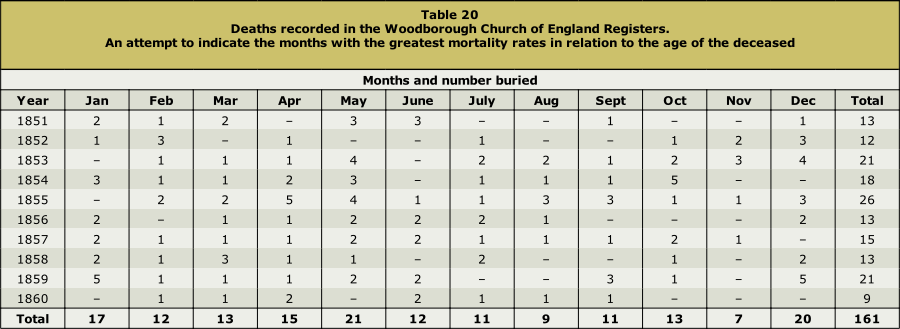
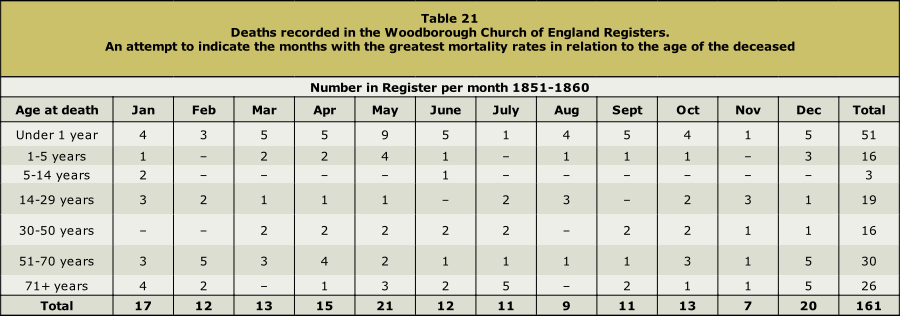


Using table 22, put another way, no less than 67 children died aged under five and the worst month, rather surprisingly, was May. Of the older people 56 died over the age of fifty-one and the worst months being predictably December to February. Of the other age groups the one with the highest mortality was, the fourteen to twenty-nine year olds with a tendency to die between October and February.
The population of the Parish was between 852 and 893 at this period. If we take 870 as the average population we find the chance of survival per age group was as follows:-
A Report on the study of the twelve largest families
(six framework knitters and six farm labourers)
who appear in the Census Return of 1851
By Mrs D. May & Mrs M. Wint
The six largest framework knitting families and the six largest farm labourers families were picked from the 1851 Census returns, of these twelve families we found no details at all of two of the FWK families in the birth, marriage or burial records. In nine of the ten remaining families we found a number of children additional to those shown in the Census, the number varying between one and six in different families. Of these ‘additional’ children, some had died, some already married by 1851, two were in service in the village and the others we assumed had left the locality.
The total number of children produced by these families, was 93, and of these 16 show up in the records as having died. 11 of these 16 died between the ages of 1 month and 11 years. According to the records, four of the families do not appear to have lost any children at an early age, whilst three of the families a number of children died whilst still only young.
In four cases the head of the family changed his occupation. One framework knitter was shown in later records as a cottager and one framework knitter became a shopkeeper. We wonder whether his framework knitting was sufficiently profitable for him to open a shop, either on a full or part-time basis. The other two were given as farm labourers at the time of the 1851 Census, but at various times prior to this were shown in records as being brick makers.
When we started this project we did think that we might find some sort of set pattern emerging, but in fact this was not so. The families all differed considerably.
In retrospect, we wonder whether it would have been a good idea to have included a few better-off families, to see how these compared with the lower paid ones and feel that we would like to do this at some future date.
A study of the fertility of a random selection of women
chosen from the 1851 Census according to occupation of husband
By Mrs A. Halliday
It was decided to make a random selection of women from the 1851 Census according to the husbands’ occupation and to try to investigate the history of their child bearing through the Parish Registers. The selection was limited to women whom the Census indicated had been born in Woodborough, as it was felt that for these people there would probably be a reasonably complete record in the Registers. In fact the record proved to be incomplete in that, in the time available for research, no age at marriage could be found for four and no age at death for six. Further research would probably bring this to light.
The women chosen were married to husbands in occupations as follows:-
5 to FWKs (also 1 shopkeeper)
3 to farm labourers
3 to other occupations (a farmer, a bricklayer and a blacksmith)
Eleven women were studied and the results, together with a summary appear below. Only one of the women SARAH CAUNT, died young (aged 28) after bearing 5 children starting at age 19. Her last two children died aged 2 and 6 months and she bore them at age 25 and 26. Only two women SARAH HERROD and ELIZABETH WOOD were married twice. The age of marriage was in all cases but one (MARIA ?) under 25 and over 18.
Four women had children had children out of wedlock SARAH CAUNT (1) whose father was a FWK and who married a FWK., MARTHA LEAFE (2) her father was also a FWK and her husband a farm labourer, MARIA ? (3) she was thirty when she married a bricklayer and ELIZABETH WOOD (2) who conceived two children between being married to her first and second husband (aged 28-32) her father was a labourer and her first husband a servant, her second husband was a FWK.
Only two of the women married twice and in four cases the husband was younger than the wife. The age of child bearing for these women was between 18 and 47 and eight of the women bore children when they were 35 or over. Out of 74 children born to these women 11 died under the age of five, but no one woman lost more than two children in this age group and two women lost none. In four out of nine families a dead infant’s name was given to a subsequent child of the same sex.
There is no indication from the statistics of these women that any serious epidemic occurred in Woodborough in the mid-nineteenth century. Of the 5 women whose date of death has so far been found the number of children born and age at death are as follows in table 24 (none of the women died in childbirth).
Comments: The fact that the Church of England Registers show a considerably greater increase in the population than is shown in Victoria County History seems to indicate two points. In the first case that the Church of England Registers may well be regarded as a fairly accurate record of those being born and dying in the village at this period (i.e. that not many births and deaths are recorded elsewhere in non-Conformist records for instance) and secondly that, as is to be expected, there was a steady emigration away from the village, probably to the towns.
A Survey of mortality in Woodborough based on the Church of England
Register for the period 1851-1880 with reference to persons who appear
in the Census return of 1841 aged 14+
By Mrs Freda Burton and Mrs Cathryn Perry
A total of four hundred and sixty four burials were recorded in the Church of England Register for the period 1851-1880. Of these one hundred and eighty one are people appearing on the Census return of 1851.
We decided to analyse these under the three main occupational headings Domestic Textile Workers, Agricultural Workers and Others. The result is as follows in Tables 15-18:-
Mobility of Labour – an analysis by place of birth of the adult male
inhabitants of Woodborough as enumerated in the 1851 Census
by Mr Colin Bayley
Introduction: The Enumerator’s Returns for the 1851 Census show the county and place of birth of all persons. Using this information, a survey has been undertaken with the objective of determining the geographical mobility of labour in the Woodborough area in the mid-19th century.
Survey Method and Problems: The basis of the survey was an analysis of the distances from Woodborough of the birthplaces of the male inhabitants over 14 years of age. Adult male inhabitants only were analysed, because it has been assumed that they have the greatest influence upon the occupation and place of habitation of the household, if married, or of themselves, if single.
The distances used from Woodborough to places shown on the Ordnance Survey map sheet number 112 were the measured straight line distances from church to church, and for other places where the approximate straight line distances from a road atlas.
The analysis has been based upon the major occupational groups listed in the “statistical report on the occupations of the people of Woodborough”. (‘Life in Woodborough 1841-1851’ First Interim Report, Section III), namely:
- Agriculture
- Domestic Textile Work
- In work other than (l) or (ll)
- Professional
- Dependants
- Independent Means
The main problems encountered in carrying out this survey were ones of determining exactly which place was being recorded by the Enumerator. The problems were threefold: firstly, some places were not fully described e.g. Notts. Sutton on Trent or in Ashfield?; secondly, for some places the phonetic spelling appears to have been used; Notts Bootton and Button – assumed to be Boughton; and thirdly, two places Notts. Southern and Leics Grinston or Gunston could not be found on the maps used.
So far as possible, these problems have been solved by adopting a common sense approach. It should be noted that 12 persons only were affected by the problems in analysing birth place.
It is not possible to satisfactorily extend this mobility of labour survey back to 1841, as the Enumerator’s Returns for that Census record only whether or not the individual was born in the County.
Survey Results and Conclusions: Table 12 below, shows the detailed results of this survey. The significant result arising from the survey is the very high proportion of the adult male inhabitants, in all occupational groups, who were born in Woodborough, and within and up to eleven mile radius from Woodborough. Nearly 90% of the adult male inhabitants were living and working in, or within an eleven mile radius, of their birthplace, and well over half of these were living and working in their birthplace.
It may be concluded, therefore, that there was little general geographical mobility of labour in the Woodborough area in the mid-19th century.
There were, however, significant differences between occupational groups. A comparison of the adult males engaged in agriculture and domestic textile work shows a higher proportion in domestic textile work born in Woodborough (67.8% c/f 49.2%), but a lower proportion born within an eleven mile radius (25.9% c/f 38.0%) and outside an eleven mile radius (5.5% c/f 11.8%). This may suggest that there was a tendency for the native Woodborough inhabitants, and their descendents, who became landless subsequent to the Enclosure of the village in 1798 to move out of agriculture and into the domestic textile industry; and for the farmers of the enclosed land to recruit labour outside the village. This movement may have resulted because the domestic textile industry in the first half of the 19th century provided a higher standard of living than did employment in agriculture.
The large majority of occupations in the “in other work” category are trades (‘Life in Woodborough’ First Interim Report Table IIIa) to which young persons were probably apprenticed. In this sector in may be expected that the skills would tend to be passed down through the generations of one family. It is, therefore, somewhat surprising that this category has the lowest proportion of native Woodborough inhabitants (42.7%), and the highest proportions of persons born within an eleven mile radius (40.0%), and outside an eleven mile radius (17.3%).
Within the general context of little immigration to the village from places more than eleven miles distant, it is interesting to note that nine of the adult male inhabitants were born in places 100 or more miles from Woodborough:
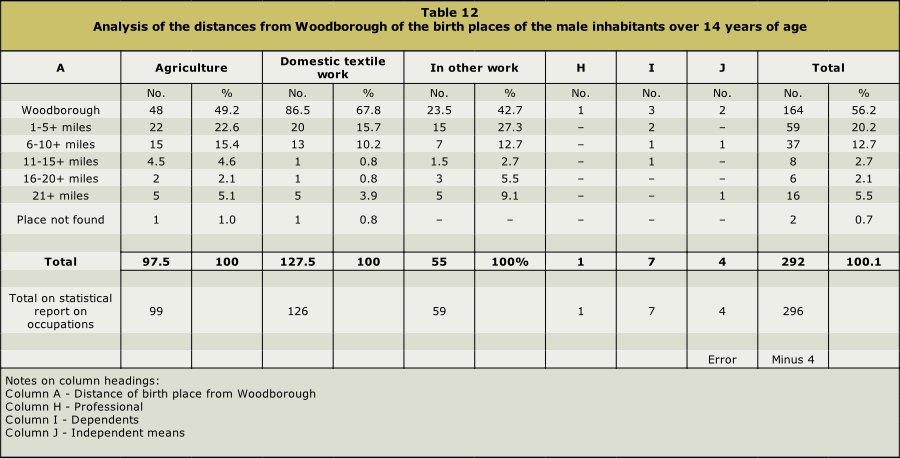

A first report on population in relation
to housing in Woodborough 1811-1851
This first report lays the foundation for future work which needs to be done on the housing of the people of Woodborough in the nineteenth century. Time did not permit more work to be done on this during the first year of investigation.

_________________________________________________________________________________________
PART III
Lines of investigation for future work which can
be done on Woodborough in the nineteenth century
Population studies based on census returns
- Ages of the population by sex
- Number of women of child bearing age (15-45), how many were married?
- The average size of families
- Age and sex of those not born in the area
- The number of “lodgers” classified under the occupation of their host families
- The occupation and place of birth of lodgers
Studies making use of Parish Registers
- The age of marriage of the women shown in the census returns
- An extension of the investigation of the number of births for the women shown in the census returns
- The age of death by sex for a further number of people shown in the census returns
Housing studies: The replacing of the people of the parish back in their correct houses at given dates. (This project is already being actively pursued by two members of the group, Mrs Freda Burton and Mrs Cathryn Perry, for the year 1851. It has not been possible to publish any findings as yet, but a considerable amount of work has already been done on maps drawn for this purpose). Does DB know anything about this?
An investigation of the number of inhabitants per house, by occupation and family size.
Occupation studies
- Children's occupations by age and sex for each child of the parish, sub-divided under the occupation of the father
- The occupation of the heads of households of the parish
- Farm size – a review of the size and number of farms in the parish at the time of the census returns
NB. Census returns are available for 1841, 1851, 1861 and 1871.
The Enclosure of Woodborough
Woodborough was enclosed in 1798. The Enclosure Award and map are available for study. This means that the making of the village landscape as it emerged at the beginning of the nineteenth century, and as it still largely exists today, can be studied. The layout of farms, hedges, drains and roads as well as the housing of 1800 can be examined. A pre-Enclosure map showing the Open Fields of Woodborough can be constructed.
Sources:
1. The abstracts and reports for the Census of 1811, 1821 and 1831.
2. The Enumerator’s books for the Census of 1841 and 1851 for the parish of Woodborough.
3. Church of England Registers for Baptisms, Marriages and Burials for the parish of Woodborough 1813 – 1890.
END OF REPORT
__________________________________________________________________________________________
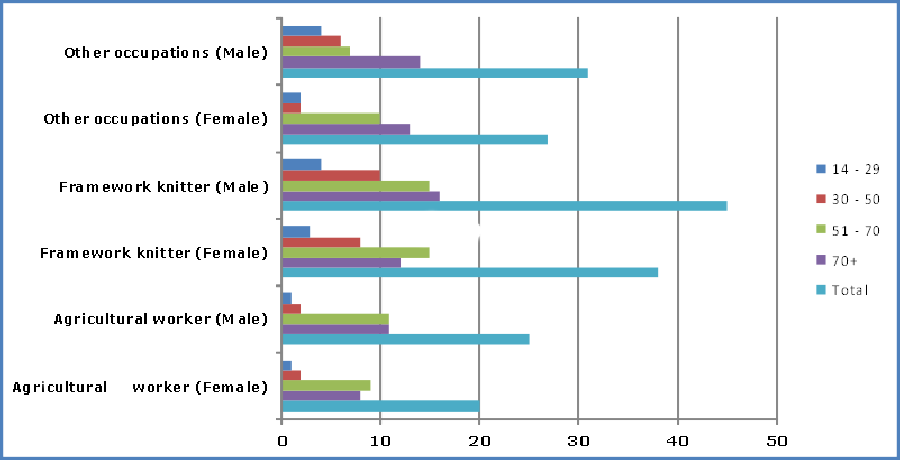
| Navigate this site |
| 001 Timeline |
| 100 - 114 St Swithuns Church - Index |
| 115 - 121 Churchyard & Cemetery - Index |
| 122 - 128 Methodist Church - Index |
| 129 - 131 Baptist Chapel - Index |
| 132 - 132.4 Institute - Index |
| 129 - A History of the Chapel |
| 130 - Baptist Chapel School (Lilly's School) |
| 131 - Baptist Chapel internment |
| 132 - The Institute from 1826 |
| 132.1 Institute Minutes |
| 132.2 Iinstitute Deeds 1895 |
| 132.3 Institute Deeds 1950 |
| 132.4 Institute letters and bills |
| 134 - 138 Woodborough Hall - Index |
| 139 - 142 The Manor House Index |
| 143 - Nether Hall |
| 139 - Middle Manor from 1066 |
| 140 - The Wood Family |
| 141 - Manor Farm & Stables |
| 142 - Robert Howett & Mundens Hall |
| 200 - Buckland by Peter Saunders |
| 201 - Buckland - Introduction & Obituary |
| 202 - Buckland Title & Preface |
| 203 - Buckland Chapter List & Summaries of Content |
| 224 - 19th Century Woodborough |
| 225 - Community Study 1967 |
| 226 - Community Study 1974 |
| 227 - Community Study 1990 |
| 400 - 402 Drains & Dykes - Index |
| 403 - 412 Flooding - Index |
| 413 - 420 Woodlands - Index |
| 421 - 437 Enclosure 1795 - Index |
| 440 - 451 Land Misc - Index |
| 400 - Introduction |
| 401 - Woodborough Dykes at Enclosure 1795 |
| 402 - A Study of Land Drainage & Farming Practices |
| People A to H 600+ |
| People L to W 629 |
| 640 - Sundry deaths |
| 650 - Bish Family |
| 651 - Ward Family |
| 652 - Alveys of Woodborough |
| 653 - Alvey marriages |
| 654 - Alvey Burials |
| 800 - Footpaths Introduction |
| 801 - Lapwing Trail |
| 802 - WI Trail |